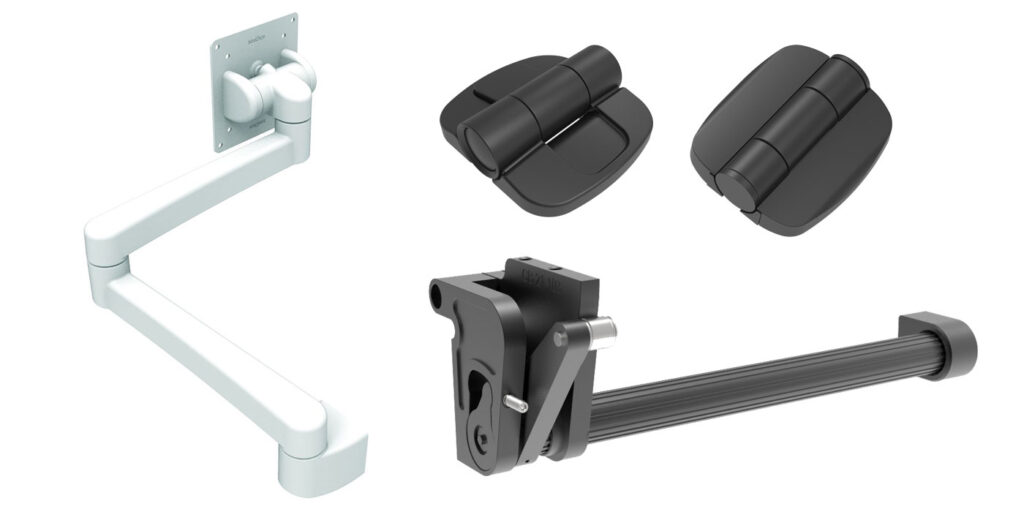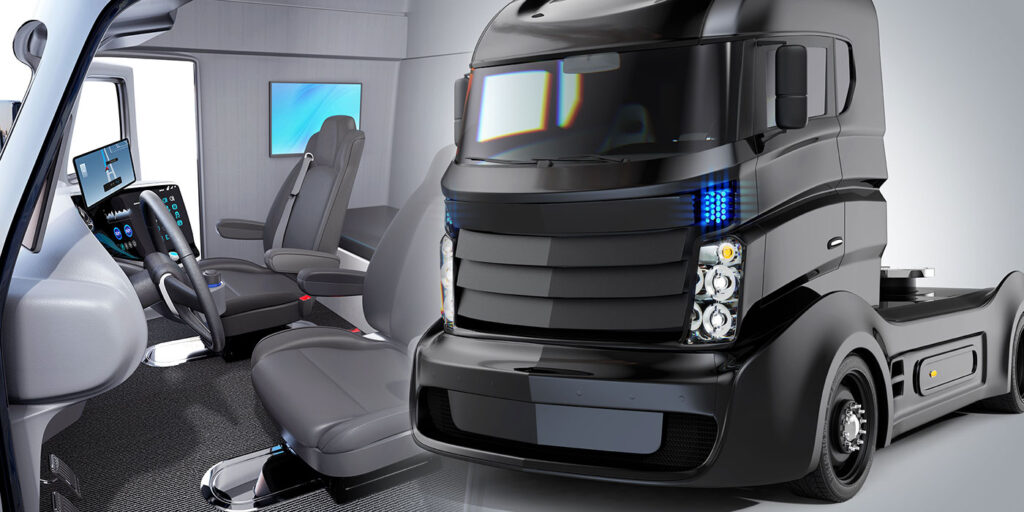The era of the long-haul autonomous truck is fast approaching. With it will come both challenges and opportunities to redesign the interior of autonomous vehicles to serve new functions and activities of those who operate them.
The advent of autonomous long-haul trucking sets the stage for significant changes in the role and responsibilities of the drivers. Instead of constantly controlling the vehicle, they will transition from “drivers” to multirole operators. This will also lead to some major changes to the design of the truck’s cabin and sleeping areas, providing opportunities for engineers and component suppliers to consider new ways that position control and access hardware products can help facilitate and serve this new architecture.
Much of the technology to support autonomous trucks is being implemented. Advanced GPS and 5G network communications technology, sophisticated onboard vehicle control systems and onboard radar and lidar sensors make it possible for these large vehicles to safely track and respond to highway traffic conditions, so they can operate autonomously for much of their time on the road.
Autonomous truck models that are either prototyped or ready for use already feature substantial capabilities: They can pull into loading docks or park themselves, maintain safe speeds and distances, change lanes, navigate automatically to and through interchanges and respond to changing traffic conditions and sudden actions by other vehicles to prevent accidents.
New role for operators changes the cabin
Presently, truck drivers have to continually manage their vehicles, even with the latest collision avoidance and brake control systems. That is expected to change with autonomous trucks, with the operator turning over control of the vehicle while maintaining a more “supervisory” role, similar to airline pilots.
This provides truck designers with the opportunity to make changes in multiple areas of the truck cab to reflect how operators on long-haul vehicles will use their cab and sleeping area spaces. For example, one truck designer is seeking to improve the driver side of the cab by exploring a way to place the brake and accelerator pedals in a box that could be moved out of the way, providing greater leg room; similar approaches are being explored for moving the steering wheel and column as well—or even replacing wheel and column with another kind of control device that’s purely digital.
These kinds of driver control modifications will require careful engineering to ensure that, if control does need to be returned to the driver, it can be done quickly and safely. To be successful, these modifications may require the use of hinges that can quickly open or reposition controls, as well as access latches that make devices fully secure when in their “out of the way” position, keeping them from suddenly shifting in response to movement by the vehicle.
With these modifications, operators will perform tasks they would normally have to postpone to times when the vehicle is not in motion. This can include handling documentation such as trip journals and paperwork related to the current loads they are delivering or the next load they are scheduled to pick up.
Fixtures to support changes in cab design and functionality
New designs for cabin and crew quarters can help fleet managers staff their vehicles with two operators, allowing the vehicle to operate over much longer distances and improve return on investment. Truck designers are modifying the passenger side of the cab to provide larger flat screens to support web, streaming video and gaming applications so it is easier to attract and staff the vehicles with two operators.
These screens can either be built into the cab console or mounted on hinges to enable users to adjust the screen’s angle. Hinges and display mounts that are designed with pre-engineered constant torque technology provide a “touch point” experience that is both ergonomic and intuitive.
Using controlled torque hinges for these display mounts offers several benefits:
• They are engineered to withstand vibration and inertial loading that may result while the vehicle is in operation
• Depending on the type of mount chosen, the displays can be easily pulled toward or pushed away from the passenger as needed
• One-handed operation allows simple one-touch positioning of displays
In order to save space and be as compact as possible, some designers are exploring having flat screens serve double duty: on one side is the display screen and the other side could serve as a flat surface, as a table to hold food, books or laptop computers.
Fixed position detent hinges can easily support that kind of configuration. They can hold doors or flat panels open at predetermined angles and eliminate the cost and labor of installing additional components to maintain consistent positioning. And just like controlled torque hinges, they are engineered for a long life span and maintain their detent angles regardless of persistent vibration from the truck.
Another significant change that vehicle designers are actively pursuing is the installation of heads-up display (HUD) capabilities for the cab. These projectors are being tested to display real-time information at the upper part of the vehicle’s windscreen or onto sun visors. They can project information about the vehicle’s speed, lane changes and turns onto exit or entrance ramps, as well as potentially incorporate side camera and rear camera video images.
Although the projectors are small, they must be securely mounted and adjusted. Compact detent hinges that can easily be incorporated into projector designs are available for this kind of application as well.

Safer and more reliable access hardware
In the era of the autonomous truck, vehicles will encounter a wide range of road conditions and vibrations, which could impact the security of cab and cabin fixtures that are folded or closed. These can include foldable tables and screens, storage cabinets, refrigerators and foldable bunks in the cabin, and even external cab enclosures like front grilles on the trucks.
Truck designers must carefully assess the type of latching and access hardware they select, to protect against accidental openings. For example: autonomous vehicles have sensitive radar and other sensors mounted on or just behind the grille; if for any reason the grille shifts or accidentally opens and blocks the sensors, the vehicle will be programmed to initiate an emergency stop.
These grilles are heavier than in the past (due to the sensors mounted on them), so reliable latching systems, such as rotary latches with one point or multipoint latches, may provide the best solution, depending on the grille design.
At the same time, these heavier grilles do need to be opened and closed — in some regions, they are required to function as a step that an operator can stand on to carry out routine service activities like refilling windshield wiper fluid. For these heavier grilles, traditional gas strut hinges may not provide the best functionality. Instead, there are counterbalance hinges that provide precise control when opening and closing heavy panels, reducing safety and liability concerns while improving end user ergonomics.
Supporting the development of autonomous trucks
The evolution of truck designs to support autonomous operation is underway. To help outfit these new designs with the right access control and positioning technology, there are advantages to working with component suppliers with experience in engineering and producing components for automotive interiors, especially those actively involved with both passenger vehicle and truck designers developing autonomous vehicles.
They can help overcome bottlenecks in design, engineering and production, as well as provide options from their existing portfolios that can satisfy cost, efficiency and performance requirements.
As Business Development Manager for Southco’s Transportation Strategic Business Unit, Steve Antcliff oversees the Automotive and Truck business growth. With a strong automotive engineering background with leading OEMs, Antcliff has worked at Southco for over three years.














